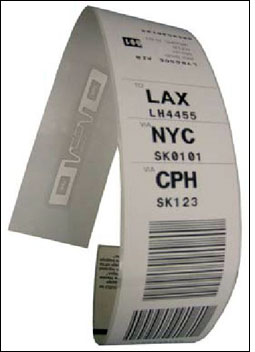Aalborg Airport, located on the northern part of Denmark’s Jutland peninsula, has replaced its bar-coding-based baggage-handling system with one that employs radio frequency identification. All information necessary to properly route the bags is saved to high-memory inlays in bag tags complying with the IATA 740c specification. The system officially became operational and was unveiled to the public yesterday.
The airport reports that it decided to employ passive EPC Gen 2 RFID tags with high memory because it wanted to implement the most up-to-date technology possible, and the price difference between high-memory and standard tags was minimal. “We want to be prepared for the future,” says Søren Svendsen, Aalborg Airport’s CEO.
Keld A. Christensen led the project for integrator Lyngsoe Systems, a Denmark-based firm specializing in RFID-based baggage-handling systems. According to Christensen, Aalborg calculated that the additional cost of RFID baggage tags compared with bar-code-based baggage tags is 10 U.S. cents, including the 2 cents more that it pays to have tags with 512 bits of user memory, instead of just the standard 96 bits for storing an Electronic Product Code (EPC).
In addition to the so-called tag license plate, the flight number and date and the routing information are all saved on the RFID inlays used by the airport. Once RFID inlays are available with a greater amount of memory, Christensen says, the airport could record additional data onto the tags, such as passenger names.
Aalborg is home to Denmark’s third-largest airport, which serves 1.2 million passengers annually and operates 30 flights daily. It estimates that it will require only 250,000 RFID tags per year, however, since many of its passengers travel domestically, without luggage.
Six months ago, the airport was planning to implement a new baggage system to accommodate an increase in traffic, and it placed a tender with providers of baggage technology. At about the same time, Lyngsoe was working with the airport on a non-RFID project to improve the flow of passenger traffic within the terminal. The facility asked Lyngsoe to demonstrate RFID solutions, and the two partners began discussing the possibility of utilizing the technology in conjunction with a new baggage system.
Aalborg airport decided to purchase Lyngsoe’s RFID system, as well as a new baggage-handling system from Crisplant. Lyngsoe began to implement the solution at the beginning of January 2010, and finished installing 20 Intermec PF2i baggage-tag RFID printers and the interrogator infrastructure in May. Only minimal testing of the system was necessary, the company reports, since Lyngsoe has implemented similar systems at other airports around the world, such as in Lisbon (see Lisbon Airport Ups Throughput With RFID Baggage System). All airlines that fly into or out of Aalborg are required to use the new system, and the airport has provided them with the PF2i printers necessary to do so.
“We are paying for the printers because we think the technology will help daily baggage handling run more smoothly,” Svendsen explains. “We decided to pay for the printers because we didn’t want to spend time discussing the matter with the airlines.”
For airline employees and passengers, the baggage-handling process hasn’t changed. Airline workers affix to bags what look like standard labels, though each label is embedded with an RFID tag.
The baggage tags are manufactured by RFID label converters George Schmitt & Co. and Bartsch International GmbH, incorporating RFID inlays from Alien Technology or UPM Raflatac.
After a passenger checks in a bag, an agent applies an RFID baggage tag to its handle and places it on a conveyor belt. The automated luggage system transfers it to the baggage hall. As it moves through the single entrance to the baggage hall, its tag is interrogated for the first time. The system records that the bag has entered the hall, and a camera at the entrance takes its photograph, which is then linked in a database to the information stored on the RFID tag.
If a security agent monitoring bags for unauthorized cargo, such as aerosol cans, detects any dangerous items via a baggage scanner, the bag’s photo will appear on that agent’s screen, as well as information from its RFID tag. If no security alarms are triggered, the bag continues to travel on the belt to the routing point.
The system then uses the information stored on the tags to sort the luggage. According to Lyngsoe, this is the first system installed that works in this way. Most other RFID baggage systems, the company indicates, store a bag’s flight-related information in a database that is merely linked to the unique ID number encoded to that bag’s RFID tag, thus requiring additional IT infrastructure.
After this second interrogation point, the system sends the bag to one of 12 chutes, depending on the passenger’s destination. From there, the luggage is moved to the tarmac to be loaded onto planes.
Since the airport has dismantled the bar-code scanning infrastructure it previously utilized, it now relies solely on RFID for sorting. RFID represents an improvement over bar-code technology, Svendsen says, because read rates are higher—that is, more than 99 percent. What’s more, Christensen notes, bar-code readers are at least three times more expensive than an RFID portal and require more maintenance.
The airport’s baggage-handlers are pleased with the new system, Svendsen says, since more luggage is sorted properly than with the bar-code system. The workers, therefore, have far fewer bags to identify manually.
Aalborg Airport spent 1.5 million Danish kroner ($246,000) for RFID hardware, software and integration services, as well as the sorter allocation system, which integrates the bag-sorting technology with the RFID system and coordinates how the baggage system runs.
Lyngsoe installed two Times-7 SlimLine A6020 RFID portals, which can interrogate bag tags from all angles, since each portal features eight reader antennas. The rectangular metal stand that holds the antennas surrounds the baggage belt completely. Two antennas are mounted on each side of the portal, two are mounted on top and two are mounted below the baggage belt. The two antennas below the belt are encapsulated in a plastic-like material to keep them from being damaged during the belt’s operation.
Svendsen says he is pleased with the improved baggage system, but that he looks forward to a more widespread use of RFID tags on luggage by other airports that will make it possible to interrogate tags on inbound bags and improve luggage flow. Once airports are widely utilizing RFID baggage tags and sharing related data, he expects to receive better information regarding late luggage headed to Aalborg. As a tardy plane containing the baggage arrives, the airport could then use a handheld interrogator to easily and quickly locate a specific bag, in order to speed up the handling process.
“That will all come,” Svendsen states. “Right now, we’re glad that our passengers are equipped with the latest technology.”



